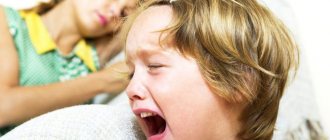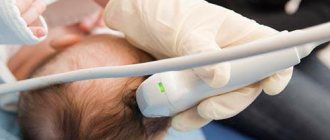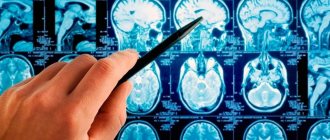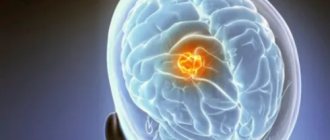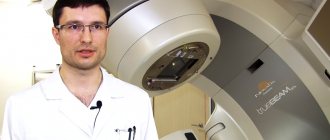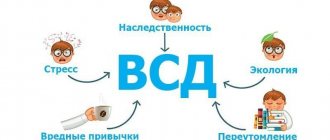Signs of cerebral palsy in children
The child learns to hold his head up, sit independently and walk later than necessary. Reflexes that should disappear by 6-8 months persist longer. Sometimes by the age of 1.5 years one arm works better because the other half of the body is weaker. Muscles can be both relaxed and overly tense, which is why the limbs have an unnatural state. Movements are too sudden or slow, often uncontrollable.
The following signs of the development of cerebral palsy in a child are also identified:
- skeletal deformity;
- asymmetry of the limbs;
- mental retardation - 30-50%;
- hearing impairment;
- speech problems;
- impaired swallowing;
- uncontrollable drooling;
- seizures - in 30% of cases;
- myopia or strabismus - 70%;
- uncontrolled urination and bowel movements.
Factors in the development of cerebral palsy
The causes of the disease include:
- premature or difficult labor
- hypoxia or asphyxia;
- infections during pregnancy;
- having a twin;
- congenital anomalies of the spinal cord or brain;
- impaired cerebral circulation;
- chronic diseases, hypo- and vitamin deficiency in the mother;
- smoking and drinking alcohol by the mother;
- Rhesus conflict.
There are often multiple risk factors present. It is not possible to name a specific reason in all cases.
Causes
By and large, hemiparesis is not an independent disease, but a manifestation of the pathology of the nervous system in which damage to the motor center or pathways has occurred.
The resulting muscle weakness leads to paresis.
Most often, the process occurs in one part of the brain and, interestingly, pathological external processes will be noticeable in the opposite direction.
That is, if the right hemisphere is affected, the left half of the body will be affected, either completely or partially, such as an arm or leg.
This occurs due to the fact that there is an anatomical decussation of nerve fibers that originate from the brain at the level of the transition of the medulla oblongata to the spinal cord.
In children
In childhood, the cause of hemiparesis can be:
- Birth injury;
- Intrauterine infection;
- Hypoxia, that is, oxygen starvation, during pregnancy or childbirth;
- Previous infections: polio, meningitis, tetanus, tuberculosis.
In adults
The cause of left-sided paresis in adults can be:
- Oncology of the central nervous system;
- Head injury;
- Degenerative diseases of the central nervous system, such as Parkinson's disease and Alzheimer's disease;
- Epilepsy;
- Consequence of a serious infectious disease: encephalitis, meningitis, tetanus, rabies, etc.;
- Thrombus;
- Hemorrhages in the head (stroke);
- Lumbosacral plexitis;
- Aneurysm;
- Frequent stress or severe one-time stress.
Forms of the disease
Types of cerebral palsy in children are classified according to ICD-10. The syndrome belongs to class VI - diseases of the nervous system. Section - Cerebral palsy and other paralytic syndromes.
- Code G80.0 - spastic tetraplegia, prevalence - 2%
- G80.1 - spastic diplegia, 40%
- G80.2 - hemiplegic form, 32%
- G80.3 - dyskinetic, 10%
- G80.4 - ataxic, 15%
- G80.8 - mixed
- G80.9 - unspecified form.
Treatment
Since left-sided hemiparesis is a consequence of the underlying disease, then, first of all, it is necessary to treat it. But at the same time, it is equally important to devote time to symptomatic therapy against hemiparesis.
In children
Mainly, in the treatment of children, emphasis is placed on:
- Classes with a speech therapist for the treatment of speech dysfunction ;
- Classes with a defectologist for developmental delays;
- Treatment of episyndrome;
- Drug therapy.
In addition to this, it can help a lot:
- Gymnastics;
- Therapeutic baths and mud;
- The use of orthopedic cribs, orthopedic shoes (website of children's orthopedic shoes);
- Surgical intervention, if necessary;
- Holidays at resorts.
In adults
To treat hemiparesis, drug treatment is used primarily to improve neuromuscular conduction. Muscle relaxants to relieve tone, medications to improve blood circulation, anticonvulsants.
In addition, adults can also be prescribed:
- Orthopedic treatment: shoes, splints;
- Physical therapy and gymnastics;
- Massage.
Water procedures:
- cold and hot shower;
- water gymnastics.
Exercise therapy and a set of exercises
A therapeutic set of exercises shows good results in the treatment of left-sided hemiparesis. You can practice both in specialized centers and at home. The main thing is that the classes are constant, or better yet, daily .
Exercise sets are usually developed individually for each patient . You can give an example of such a system of exercises as:
- Pulling the chin to the chest;
- Tilt of head to shoulders;
- Rotational movements of the hands;
- Raising your arms to shoulder level;
- Rotational movements of the feet;
- Raising on toes;
- Flexion and extension of the legs in a lying position;
- Raising your legs while lying down.
We invite you to visually familiarize yourself with an interesting video on the topic:
Child development with cerebral palsy
Psycho-emotional characteristics manifest themselves in different ways: some children are irritable, excitable, and suffer from sudden changes in mood. Others are shy, fearful, and have difficulty communicating with people.
Restriction of physical activity causes curvature of the spine, contracture and internal pathologies. Due to speech impairments, meaningful communication is limited or absent. Parents should not show excessive pity and impressionability in their upbringing. It is necessary to praise the child more often, encourage him to take active actions, and form normal self-esteem; all this is very important for the normal development of the child. Parents should help the patient adapt socially.
Cerebral palsy (CP) - symptoms and treatment
For the treatment of cerebral palsy, it is important to have an early start, an individual approach, continuity and succession at different stages (when each specialist supports and improves the results achieved by the previous doctor). Treatment is combined with educational work, occupational therapy (medical rehabilitation that teaches the patient to restore or acquire everyday skills, occupational therapy). It is necessary to include the child’s family members in the work to comply with the principle of continuity [5].
There are several main approaches to the treatment of cerebral palsy:
- Method of functional therapy - kinesiotherapy, exercise therapy, physical therapy, hardware kinesiotherapy, functional massage techniques.
- Conservative orthopedic treatment - orthosis, casting, postural management (use of technical means of rehabilitation - verticalizers, seat supports).
- Drug treatment with oral antispastic drugs.
- Botulinum toxin preparations , which belong to the group of local muscle relaxants and reduce spasticity. The drug relaxes the spastic muscle into which it was injected. They do not have a systemic effect, that is, they do not affect internal organs and the brain, but act only at the injection site.
- Intrathecal (injection into the bone marrow membrane) of baclofen using a pump is a constant injection into the space between the hard shell of the spinal cord and the yellow ligament using a pump into the patient’s body of the drug “Baclofen”, which has a systemic effect and relaxes all spasmodic muscles. The big disadvantage of the drug is the need to monitor the dose and refill the pump. Pump installation is available only in large federal and territorial clinics.
- Orthopedic surgery includes a large number of different operations that are aimed at lengthening muscles, restoring the hip joint in case of dislocation, forming a correct arch of the foot and full support of the foot, restoring a more even posture in case of scoliosis.
Treatment approaches are used depending on the severity of cerebral palsy and the age of the child. Functional therapy, conservative orthopedic treatment and postural management can be used from a very early age. Botulinum therapy is usually used from 2 years of age . The use of these approaches in combination with continuous long-term treatment and correction of all comorbid (associated) disorders ensures the high effectiveness of complex treatment. Oral antispastic drugs for cerebral palsy are often used to a limited extent due to the development of systemic side effects.
When treated with botulinum toxin type A (BTA), the maximum possibility of disease modification is observed at the age of 2-5 years . At older school age, botulinum therapy helps to solve local motor problems, reduce pain from prolonged spasms, facilitate care for patients with severe motor disorders, and also maintain the body in a sitting or standing position [8].
Kinesitherapy is a method of teaching and restoring a child’s motor activity through repeated repetitions of physiological movements, taking into account the ontogenesis of motor skills. The most effective methods are Vojta therapy, Bobath therapy, and PNF therapy [7].
An integral part of the rehabilitation process for children with cerebral palsy is psychological and speech therapy assistance and social adaptation. It consists of teaching children speech skills, communicating with other children around them, developing fine motor skills, and teaching self-service skills.
Orthopedic treatment helps eliminate contractures and deformities, as well as create a rational position for the child. Treatment includes special therapeutic positions during rest and sleep hours, staged correction of contractures using plaster splints and circular bandages. Of great importance is the prevention of secondary deformations and contractures in children during the period of rapid growth at 5-7 years and then from 12-15 years , when there is a tendency to the formation and recurrence of contractures.
For persistent contractures, surgical treatment is performed, but not earlier than 3 years of age , since active bone growth occurs before this and with early surgical treatment, relapses may occur due to the growth of the child. In modern neuroorthopedics, they try to delay surgical treatment as long as possible so as not to cause setbacks in the future.
In the postoperative period, the development of optimal positions of the body and limbs, rational compensatory devices, and the development of self-care skills continues. Prosthetic and orthopedic support is essential - the selection and adaptation of special auxiliary devices that help correct posture: verticalizers, seat supports, walkers, splints, devices for the lower limbs and torso [7].
Diagnostics
You should contact a neurologist if you suspect the development of cerebral palsy in a child if:
- at 1 month he does not blink his eyes at loud noises;
- at 4 months does not reach for toys and does not turn towards sounds;
- at 7 months does not sit independently;
- at 1 year of age does not speak words and acts with one hand;
- does not walk or moves incorrectly;
- experiences convulsions;
- makes sudden or excessively smooth movements.
To make a diagnosis, a neurologist studies the medical history, pregnancy and childbirth, and conducts an examination. Blood tests, urine tests, and MRI are prescribed. As well as a number of studies to exclude genetic diseases.
